Optimizing Baseball Training With Infrasternal Angle (ISA): Individualizing Programs for Hitters and Pitchers
The ISA fundamentally affects movement because it influences how the thoracic ribcage and spine flex, extend, rotate, and stabilize. In narrow ISA individuals, the ribcage is biased toward external rotation (ER), favouring movements that require rapid rotation and elastic recoil. In wide ISA individuals, the ribcage is positioned with a more significant internal rotation (IR) window, suiting them for compression-based strength exercises and sustained force production over wider ranges of motion.
HOW WE EVALUATE POWER WITH PROTEUS MOTION
Traditionally, power has been difficult to measure given that it is the product of other metrics (force and speed) and is also produced three-dimensionally. Proteus, however, allows us to evaluate an athlete’s power accurately, how much force and velocity contribute to it and visualize their power production in three dimensions.
Hitting: How Movement Screening Informs the Training Process
For hitters, a key part of the Velo Baseball experience is going through your initial assessment which includes a movement screen and a swing analysis. Movement screening uses a series of basic tests to determine if the athlete has any mobility (usually tightness) or stability (usually lack of strength) issues.
Skill inhibitors & physiology: How are they related?
We see it time and time again, an athlete will come in for an assessment and explain to us all of the mechanical adjustments they’ve been trying to implement based on a their favourite professional baseballer or that have been assigned to them from a previous trainer or coach. While this is great in theory, most athletes become frustrated with the process of trying to make mechanical adjustments and often revert back to what feels familiar.


